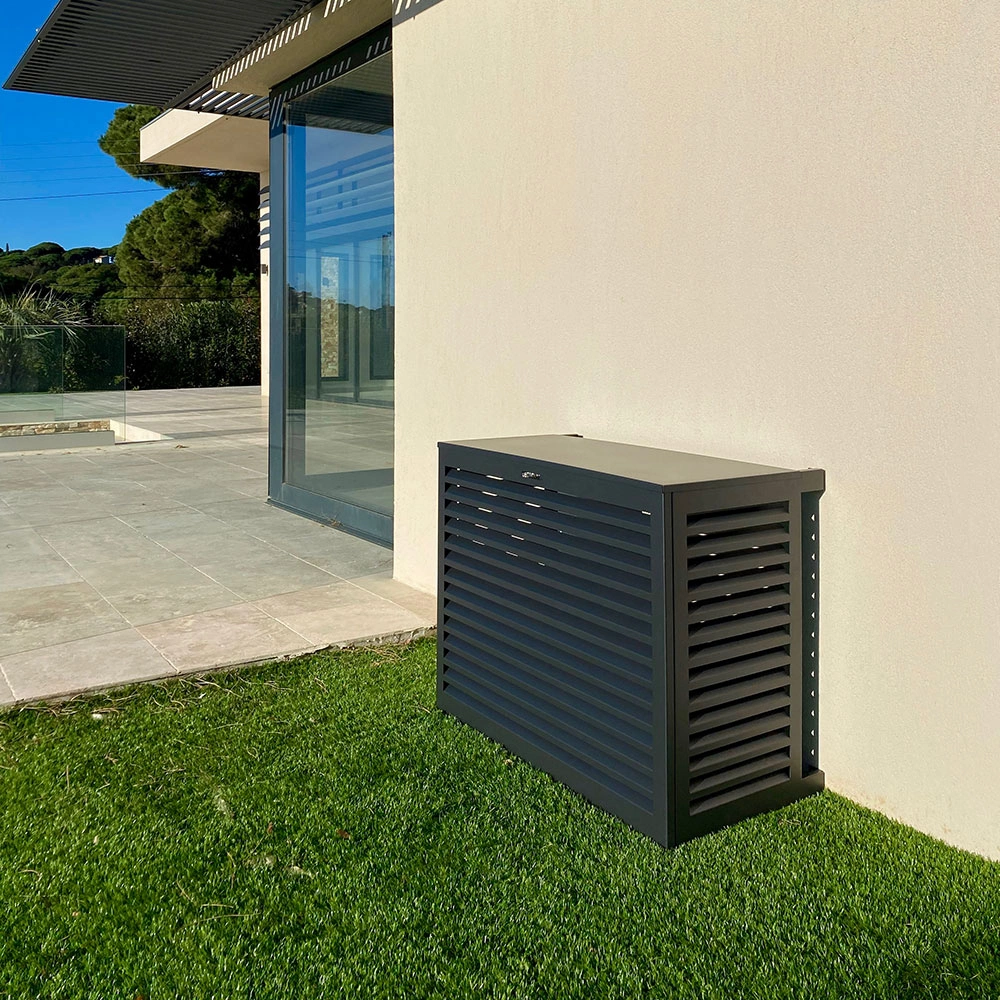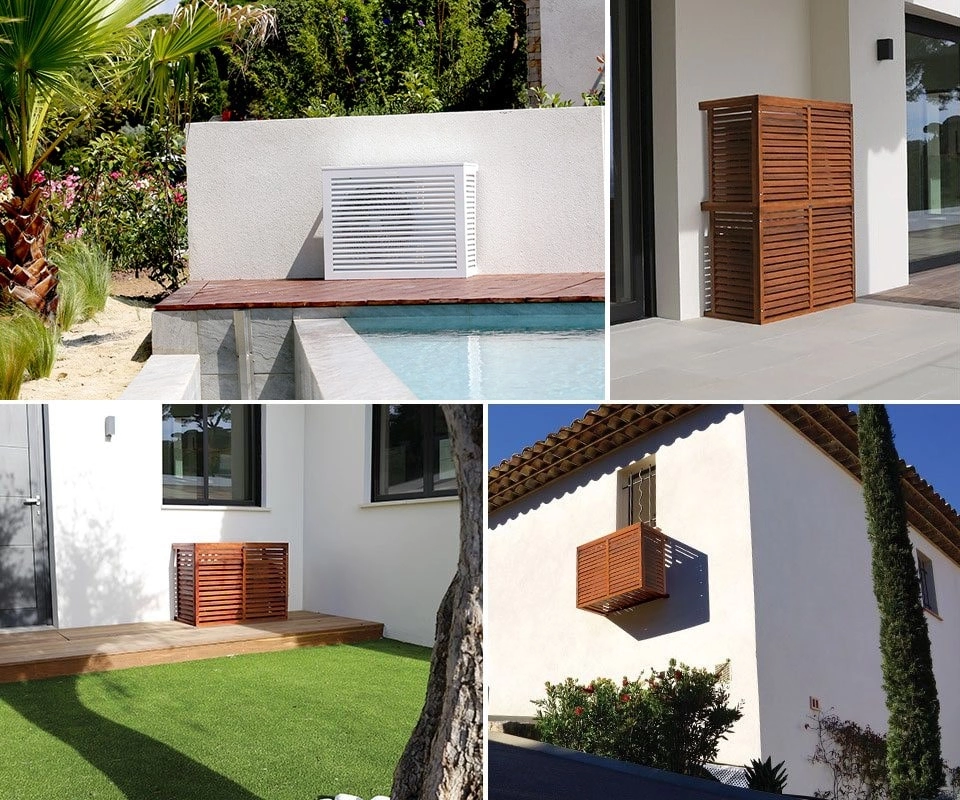The motor unit of an air conditioner located outside the home is exposed to multiple risks that can alter its operation and performance. We explain to you why it is useful to provide protection for your outdoor air conditioning, and above all the advantages and disadvantages of the different possible solutions between outdoor air conditioning formwork, protective cover, garden shed, plant screen... to allow you to make the right choice.
WHY PROTECT YOUR OUTDOOR AIR CONDITIONER?
Here are the main risks that can affect the proper functioning of the device:
The vagaries of the weather
The vagaries of the weather influence air conditioners in more ways than one.
- Strong winds can disturb the rotation of the fan or send leaves, stones or branches into the device.
- The sun's rays can cause the motor to overheat.
- Temperatures that are too low can freeze the circuit and prevent the reversible air conditioning from operating in winter when the temperature drops below 3 degrees.
- Not to mention the snow that can stagnate on the machine...
Children's games
Children do not always realize the consequences of their games.
If they get the idea of introducing branches or leaves through the grilles of the air conditioner, pebbles, or any other object, if they have fun spraying it with all kinds of liquids... this could unfortunately damage the operation of the device.
Furthermore, it is also not perfectly ideal for their safety to leave an electrical device within easy reach of their fingers with free and direct access.
Here the need for protection is therefore twofold: protect the device and protect children .

Vandalism, animals and theft
Since the motor unit of the air conditioner is located outside, it is more complicated to guarantee its monitoring and safety. It is thus exposed to a rarer but real risk of damage and theft by malicious individuals. More candid but no less sources of damage, animals can finally be a source of nuisance for the integrity of the machine.
As we can see, the reasons for protecting the outdoor unit from its air conditioning are therefore numerous, and make it possible to:
- Guarantee the efficiency of the air conditioning at the best performance
- Avoid over-consumption of the air conditioner
- Increase the life of the installation by avoiding breakdowns, malfunctions and over-speeding.
Now that the need for air conditioner protection is clarified, let's review the different possible alternatives, their advantages and disadvantages.
WHAT SOLUTIONS FOR THE PROTECTION OF AN OUTDOOR AIR CONDITIONING UNIT?
First, it is important to specify it in the preamble, know that the outdoor air conditioner ALWAYS needs perfect ventilation all around it to work.
So quickly forget any idea of covering the device with an airtight protective box that would prevent the air from circulating properly. It would be totally counterproductive!
Choosing the right location for the air conditioning unit outdoor unit
The first thing to do, when possible, is to choose the right location to position the outdoor air conditioning unit.
It is particularly advisable to avoid places that are too sunny (avoid facing south) or too exposed to the prevailing winds which could disrupt the operation of the fan.
If your air conditioner is reversible and must operate in winter, consider a location likely to protect it as much as possible from temperature drops (avoid northern exposure in this case) because if the temperature approaches 0 your reversible air conditioner or your heat pump may well struggle to warm you up.
But sometimes we don't have a choice of location, and sometimes also, a good location is not enough to protect the outdoor air conditioner. Other solutions must therefore be considered.

An air conditioning formwork that houses and dresses it at the same time
It is a simple and effective solution to protect the outdoor air conditioner , as long as you choose the right model.
A box for air conditioning with louvers allows the air conditioner to be sheltered while allowing perfect air circulation around the machine thanks to louvers designed to allow air to enter and leave without hindrance.
Beware, however, of models of casings for air conditioners where the openings for ventilation are simple holes. This design certainly costs the manufacturer much less than the louvered models, but the "hole" models offer openings that are too small for sufficient air renewal and this may quickly have an impact on the performance or the life of the your appliance, air conditioner or heat pump.
The other notable advantage of housings for outdoor air conditioners is aesthetics. In addition to protecting the air conditioning, they simultaneously hide the machine that disfigured your facade or your garden under a decorative and discreet covering that makes you forget it.
In addition, the air conditioner covers are generally easy to remove when you need to access the device for its annual maintenance.
Last asset, and not least, these air conditioning covers also act as sound insulation. Some formwork makes it possible to reduce the noise pollution generated by the air conditioner by 10 to 30%. Enough to find calm…and serenity with the neighborhood.
Of course, not all air conditioning covers are created equal. For example, it is better to opt for a sturdy aluminum exterior air conditioner cover or an exotic wood air conditioner cover treated to resist UV and rain if you want to ensure its longevity.
On the installation side, they are generally very easy to install yourself, even when you are not a handyman and come in different sizes. You will therefore necessarily find shoes for your air conditioning.
Make your own protection for your air conditioning in DIY mode
If you are a DIY ace, you can try to build your own protective formwork by following a tutorial. But if we find various and varied tutorials on the Internet, they are not all recommendable because some do not allow sufficient air circulation. Never forget that your creation must allow air to pass all around the device so that it cools the device, and that the air is renewed sufficiently so as not to degrade the performance of the air conditioning and generate over-consumption.
In addition, some tutorials allow you to hide the side walls but not to protect the top of the device, which can cause problems.
So be careful, don't go headlong into the first tutorial before you have studied its design well.
Install a plant screen
If your air conditioner is installed in the garden or on a terrace, you can consider a plant screen consisting of a planter or a hedge of shrubs. It is a solution which has the advantage of offering a beautiful natural finish, but which requires a few precautions.
Therefore, always provide access to the device because it requires regular maintenance.
Choose resistant plants whose foliage remains in all seasons so as not to find yourself without protection for several months of the year.
And leave enough space between the machine and the plant cover.
Do not forget that you will also need to maintain the plants and prune them regularly so that they do not touch the device, let the air circulate and that leaves do not interfere with your machine and clog it.
If the installation of a plant cover may seem an easy idea, it thus has major drawbacks and insecure protection against a certain number of risks listed above.
Place the air conditioning in a well-ventilated garden shed
If you have a garden shed, you can consider placing your outdoor air conditioning unit there, but if and only if the room is sufficiently ventilated for the air conditioning to cool and the air to circulate.
Be careful because this is not the case for all garden sheds.
What about fabric protective covers for outdoor air conditioner?
They are certainly not expensive, but protective cloth covers can only be used when the device is NOT in use to protect it from dust or debris.
It is therefore a really partial solution because the cover must absolutely be removed when the engine is running.
Indeed, this type of protection is not equipped with ventilation openings, so it does not allow the circulation of the air necessary for the proper functioning of the air conditioner.
For effective protection in all seasons, it is preferable to opt for a suitable louvered formwork.
READ MORE AIR CONDITIONING TIPS:
- How to reduce air conditioning noise?
- How to hide your outdoor air conditioner? Ideas, tips and tutorials
- Understanding everything about air conditioning
- Installing air conditioning: necessary authorizations, regulations and legislation
- Air conditioning cover with louvers or holes? Fabric cover, wooden or metal box? Opinion and comparator to choose well
- How to air condition an apartment


